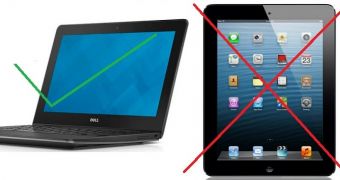Once upon a time, Apple was a very big presence in the educational sector, and a week didn’t go by without hearing that some new school district in the US had just purchased a ton of iPads for their students and staff.
However, what was once does no longer apply. A new trend is emerging in American schools, where students and teachers aren’t warmed by the thought of an iPad. Instead, they are cheering Chromebooks.
For some, this development might seem counter-intuitive, given that the iPad has been hailed as a breakthrough tool in education, allowing students and teachers to make the transition from the drab traditional textbooks to the online environment, where creative lesson apps tap into the imagination of students.
The iPad was taken up in wealthy schools that had the resources to purchase these high-end devices, but less wealthier educational establishment weren't left out in the cold either, as the government granted special funding to purchase the tablets.
But not all school rushed to jump in the Apple bandwagon. For example, back in 2012, Hilsborough gave Chromebooks a chance and made an experiment. They wanted to know what kids interacted better with, from the source.
So they granted 200 kids Chromebooks and 200 kids iPads, and let them use throughout the school year, expecting feedback at the end. The result?
In 2014, pupils in Hilsborough class rooms only use Chromebooks. The school has decided to sell its iPads and buy more Chromebooks instead (it will give 4,600 students Chrome OS laptops by this fall).
Not only students seem to benefit from this decision, but teachers agree that Chromebooks work much better to achieve the end goals in a classroom environment.
Sure, a few teachers involved in the pilot admit that they were disappointed that they did not get iPads at first, but after seeing children interact with Chromebooks, they changed their minds completely.
The trouble is that children perceived the iPad as a realm filled with possibilities of fun and games, while the Chromebook came with a more austere face that invited them to get to work. Furthermore, the experiment showed that when students tried to type and annotate on the tablet, the Chromebook’s keyboard proved to be a lot more useful.
More than that, since everything on a Chromebook lives in the “cloud” if a certain device breaks, the files are safe and can be accessed from a different device.
Educators too have warmed up to the Chrome environment through Google’s Apps for Education suite. At Hillsborough, Chromebooks are being backed up by 3,000 Nexus tablets offered by Google in a new pilot program.
So, the Hillsborough experiment proves quite elegantly that in a school setting, Chromebooks work best.
The laptop-tablet debate has going on for some time now, especially related to the business sector and almost every time it has been found that tablets aren’t yet capable of replacing notebooks, which remain more productive. But this applies in the educational environment as well.
Most importantly, Chromebooks are a lot less expensive when compared to tablets and laptop/tablet hybrids. A Chrome OS laptop starts at $279 / €208, while the iPad starts at $399 / €298. Popular convertible options like the Microsoft Surface Pro 3 sell for $799 / €598.
Chromebooks have yet to become replacement for productive business laptops, but Education is one sector where they are thriving, and we don’t think that they will be going anywhere anytime soon.

 14 DAY TRIAL //
14 DAY TRIAL //